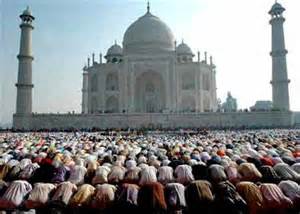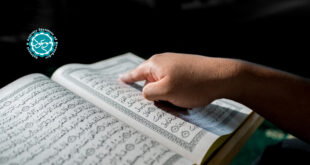Some Dutt Brahmins, under the leadership of one Bhurya Dutt, got together with Mukhtar Saqaffi to avenge the death of the Imam. They stayed behind in Kufa, while the rest returned to India. Here they built up a community of their own, calling themselves Husaini Brahmins, and although they did not convert to Islam they kept alive the memory of their links with Imam Husain.
The Husaini Brahmins believe that Krishna had foretold the event of the Imam’s death at Karbala in the Bhagwad Gita. According to them, the Kalanki Purana, the last of eighteen Puranas, as well as the Atharva Veda, the fourth Veda, refer to Imam Husain (A.S.) as the divine incarnation or avatar of the Kali Yug, the present age. They hold Imam Ali (A.S.), Imam Hussain’s father, and son-in-law and cousin of the Holy Prophet Muhammad, in particular reverence, referring to him with the honorific title of Om Murti.
Universalization of Muharram Ceremonies in India
The Imambara is an Indian institution more popular with the Shi’a Muslims who assemble here during Muharram, the first month of the Islamic Calendar. Unlike a mosque, there is no set pattern for an Imambara. Its style, architecture and unity vary with local cultural influence. In south India, for instance, it is called an Ashurkhana.
Shias in particular perform Matam (beating their chest), recite Marsiyas. Processions are taken out with Tazias (huge bamboo structures decorated with paper and tinsel representing Imam Husian’s mausoleum) and Alams (replicas of the ensign of Imam Husain (A.S.), during the battle of Karbala). Tamerlane is believed to be the founder of the Tazia ceremony in India. As a devotion to Imam Husain (A.S.), he erected the first Tazia and carried it on his military pursuits. Gradually the Mughal emperors perfected and promoted this art in India.
The Imambara
The pivotal point for the Muharram activities is the Imambara. In India Imambaras or Ashurkhanas are more prominent in places patronized by the Shi’a Muslims. The earliest kingdom to declare Shiaism as state religion in India was the Adil Shahis of Bijapur, followed by the Qutb Shahis of Golconda. The Awadh rulers of Lucknow and some of the Nawabs of Bengal were devoted Shias who observed Muharram with due sanctity.
Alams during the Qutb Shahi rule were made out of gold and silver with jewels studded in them. As they symbolized the martyrs of Karbala, upon them be peace, royal privileges like armed escorts, Naqqar Khana and Chattr were accorded to them.
Ashurkhanas
Numerous Ashurkhanas dotted the Deccani Kingdoms of Adil Shah and Qutb Shah. One of the best preserved is the Badshahi Ashurkhana, not far from Hyderabad’s world-famous monument Charminar. It was erected soon after the completion of Charminar in 1592. This Ashurkhana has an impressive height and is noted for its profusion of Persian tiles. Once it boasted of 14 gold Alams and 10,000 lamps that spoke of the grandeur of the Sultan.During the Asaf Jahi period which lasted in Deccan till 1948 efforts were made to revive the glory by introducing new Alams and European lamps. (1)
Most of the Ashurkhanas of Hyderabad are gifted with proud historic Alams or some piece of memorabilia. Koh-e-Moula Ali on the hillocks of Hyderabad is reputed for its Nishan (hand impression of Hazrat Ali); others have preserved the historic swords, fragments of the armour cap, etc. One such proud possession is Hazrat Fatima’s chaddor. The box in which this relic is kept bears the seal of several emperors. Bibi Ka Alam contains a piece of wood on which the funerary bath of Hazrat Fatima (A.S.), the daughter of Prophet Muhammad was performed. (2)
Awadh was another Shia kingdom with Lucknow as the capital where numerous Imambaras were built by different nawabs. There hardly used to be any mohalla in Lucknow that did not boast of a couple of Imambaras. The three best known Imambaras of the city – the Asafi or Bara Imambara in the old city, the Chota Imambara in Hussainabad and the Shah Najaf Imambara near Hazratganj – are famous for their architectural beauty and European chandeliers.
Urdu Marsiay and Nohay
Urdu marsiay and nohay, or elegies, have not only rendered to the Urdu language literary and poetic beauty, but also a medium of religious, cultural, and intellectual expression. Although some Urdu marsiay and nohay deal with topics other than the seventh-century battle of Karbala, most of them have focused on the events that paved the path to this battle and the agonizing aftermath of this event. (3) There are many Hindu poets in India who have composed Urdu marsiay and nohay in the praise of Imam Husain (A.S.).
Muharram ceremonies in India serve to unite the Muslims in India as well as bring the non-Muslims closer to them. The local customs and traditions concerning Muharram in rural areas of India have created for rural Muslims the psychological stability and security. Muharram rituals in India have played a vital role in the very survival of Islam, especially in the various far-flung rural communities of this vast sub-continent.
The Taziya, Alams and Mehndi attract the attention and devotion of Hindus and are very popular among them. They visit the Taziyas for darshan (homage) and make mannats (vows) and give offerings. In India the Muslims and Hindus are united in seeking solutions through the Taziyas. Apart from the Taziyas, the Muharram ceremonies always increase inter-communal interaction. Muharram affords an excellent opportunity for mass participation and collective performance of rituals on joint basis by Muslims and Hindus.
Sufi Saints Contribution in the Cause of Interfaith Understanding in India
In India, Islam was propagated, upheld and revitalized by the Sufi saints. The people who loved these men often built beautiful structures around their tombs (dargah), sometimes with an adjoining mosque. These darbars are dargahs as they are called became places of homage and reverence by the Muslims and Hindus. Sufism was primarily introduced in India for spread of Islam and the Sufi saints tombs emerged as a place of pilgrimage for spread of Islam.(4)
The numerous Sufi religious establishments in India were the major means of spreading Islam and adapting it to indigenous cultural tradition. Of the various Sufi orders, Muslims of India prominently follow Chistiyya, Naqshbandiyya, Qadiriyya and Suhrawardiyya orders.
For centuries the Hindus accepted Sufi shrines as symbol of communal harmony. A large number of them offer prayers at the tombs of the Sufi saints. The Sufi saints wrote in local language or even dialect and hence were much closer to the people. Popularity of these Sufi saints in India is indeed tremendous.
The famous Sufi saints who contributed greatly in propagating the message of Islam in India were Baba Farid (died in 643 A.H.) in Pakpattan, Nizamuddin Aulia (died in 724 A.H.) in Delhi , Khwaja Bande Nawaz Gesudaraz (died in 826 A.H.) in Gulbarga,, Shaykh Ahmad Abdal in Rudauli, Bakhtiyar Kaki (died in 634 A.H.), Nasiruddin famous as Chirag Dehli (died in 769 A.H.), Shaykh Sirajuddin (died in 759 A.H.), Ashraf Jahangir Semnani (died in 808 A.H.), Shaykh Saleem Chishti, Syed Ali Hamadani famous as Shah-e-Hamdan (died in 786 A.H.), Ahmad Yahya Maneri (died in 773 A.H.), Muhammad Ghouse Gwaliori (died in 971 A.H.), Nur Qutb Alam, Baba Adam Shaheed, Shah Jalal Sufi, Khan Jahan Ali, Badr al-Din Shah, Shah Maqdoom in Bengal, Abdullah Shah Ghazi in Karachi, Syed Ali Hujwairi in Lahore, Shaykh Zakaria, Shah Shams Sabzwari, Shah Ali Mardan and Shah Yusuf Gardezi in Multan,
 Mouood Mouood English Edition
Mouood Mouood English Edition




